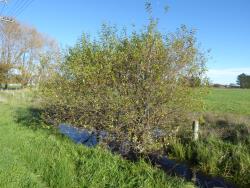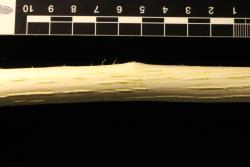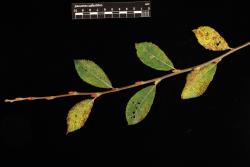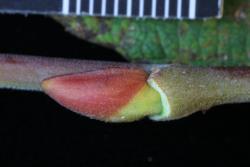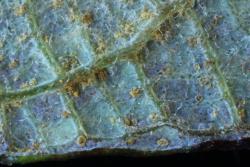- = Salix cinerea subsp. oleifolia Macreight, Man. Brit. Bot. [Macreight] 212 (1837)
Multi-stemmed shrubs with erect branches, to 5 m tall, bark grey, smooth. Branchlet wood ridges (8)12–30(33) mm long (average 16 mm long), dense. Current year's branchlets densely velvety, hairs silvery. Year-old branchlets light olive-brown (UCL94) to mid-brown (UCL58), densely tomentose, becoming completely glabrous by the 2nd year, 2.2–3.9 mm diameter, averaging 2.7 mm diameter. Bud scales 5.0–6.5 mm long, 3.0–4.3 mm wide, 2.7–3.2 mm deep, ovoid, with 2 indistinct angles, sparsely short-silky hairy, dark orange-yellow (UCL72) to mid-brown (UCL58). Leaves alternate. Stipule in mid-summer 3–6 mm long, ovate, strongly toothed, hairy, not persisting. Petiole 6–12 mm long, densely velvety, adaxial groove absent, glands absent, base of petiole not expanded, pale yellow. Emerging leaves green, with moderately dense tomentum on both surfaces, hairs mostly silver but some brown hairs present, most commonly on lower leaf surface. Proximal leaves entire. Leaf lamina 32–76 mm long, 17–35 mm wide, length to width ratio 1.7–3.0:1, elliptical or obovate; base rounded; apex acute; leaf galls absent; orange rust abundant in late summer; margins serrated and crenate, finely revolute, teeth project from margin; upper lamina surface slightly bullate due to impressed veins, slightly glossy, in mature leaves glabrous but midvein remaining densely tomentose, stomata absent; lower leaf surface distinctly glaucous, all veins raised, moderately densely tomentose, hairs a mixture of silver and brown. Catkins female or male, emergence coetaneous with leaves. Flowering branch 22–25 mm long, with 0–4 reduced leaves. Male catkin 20–23 mm long, 8–19 mm diameter; catkin rachis not visible between flowers. Female catkin 25–40 mm long, 9–12 mm diameter; catkin rachis not visible between flowers. Flower bract 1.5–3.2 mm long, 0.7–1.0 mm wide, dark brown in upper half, flat; apex rounded, acute to obtuse; long-silky hairs dense on both surfaces and margins; female bract persisting. Male nectary 1, 0.45 mm long, 0.3 mm wide, greenish yellow. Stamens 2, filaments free, hairs on the lower half; anthers 0.7–1.2 mm long, yellow, tinted orange before opening. Female nectary 1, 0.5–0.9 mm long, 0.24–0.3 mm wide, yellow-brown; ovary 2.5–4.2 mm long, densely short-silky hairy; stipe 1.3 mm long extending to 2.0 mm after flowering; style base 0.4–0.5 mm long, style arms 0.6–0.7 mm long, unlobed, stigma pale green.
Salix atrocinerea shares with S. cinerea dense, long wood ridges but has brown hairs on the lower leaf surface, which are absent from S. cinerea. Argus (2010, p. 133) says, "The presence of ferruginous hairs on the leaves of Salix atrocinerea is the best diagnostic characteristic, but they are not always present or easily observed". A dissecting microscope or a 10–20× hand-lens with strong light is needed to see these hairs. The brown hairs are observable on the leaves of dried specimens, but they are not on the bud scales, branchlets, leaves below the catkins, or in the catkins themselves. They vary in density, usually densest near the margin of the lower leaf surface but can be on both surfaces. In the wild, S. atrocinerea can be recognised by the slender terminal branchlets (on average 2.7 mm diameter). They are smaller in diameter than in S. cinerea (on average 3.1 mm diameter) but very similar to branchlets of S. ×reichardtii (on average 2.8 mm diameter), which differs in having short, sparse wood ridges.
Both Salix atrocinerea and S. cinerea are common in the wild in New Zealand, but S. atrocinerea appears to be the more common species. They, and the hybrid S. ×calodendron, are the only willows in New Zealand with dense, long, wood ridges. Both have obovate leaves when young and elliptical mature leaves. Both S. atrocinerea and S. cinerea vary in the density and persistence of hairs on both leaf surfaces. Salix atrocinerea tends to have less dense hair cover on the lower side of the leaves at all stages of leaf development. The hairs are more crumpled and lie in random directions, while in S. cinerea they tend to be straighter and either aligned towards the leaf apex or almost erect. Salix cinerea appears to have a narrower ecological range than S. atrocinerea. In the UK and in New Zealand it is found on stream banks, and in marshes, bogs, and swamps, while S. atrocinerea is found in such wetlands, but also occurs in better-drained soils. The first leaves to emerge with the catkins lack brown hairs; at this stage S. atrocinerea has to be identified by the dense, long wood ridges and the slender branchlets alone.
A variegated cultivar has been collected (from North Canterbury 1970 and Travis Wetland 1996), which has brown leaf hairs present and slender terminal branchlets and belongs in S. atrocinerea. This cultivar is probably referable to S. cinerea 'Tricolor' (Bean 1980) and is probably S. cinerea var. tricolor Dipp. (Kuzovkina 2015, p. 61).
Auckland (West Auckland 1989, Birkenhead 1975, Huia Bay 1982, Piako River 1959, Paeroa 1970, Whangamarino Swamp 1981, Hamilton 1945, Ōhaupō 1958, Te Kuiti 1963, Huntly 1958, Whangamarino River 1982, Lake Karapiro 1958), Gisborne (Ōpōtiki 1975, Waioeka Gorge 1975, Bay of Plenty 1940, Ngawaro 1965, Mayor Island 1992), Volcanic Plateau (Lake Rotoroa 1984, Lake Rotoiti 1992), Taranaki (Eltham 1996, Waiwakaiho River 1987), Southern North Island (Wellington 1948), Sounds-Nelson (Kaituna 1971, Upper Maitai River 1971), Westland (Kumara 1963–1965), Canterbury (Christchurch 1964–1988, Leeston 1963–2018, Lincoln 1963–2018), Otago (Dunedin 1949, Port Molyneux 1991, Kaikorai Estuary 1990), Southland (Eyre Mountains 2016), Longwood Range (1976).
First collection: Pongakawa River, Bay of Plenty, K. W. Allison, October 1940, CHR 36698.
First publication: Sykes 1982 (p. 1168).
Flowering: Early August–late October.
Tetraploid, 2n = 76 (CCDB), provisionally confirmed by flow cytometry using PN227.



